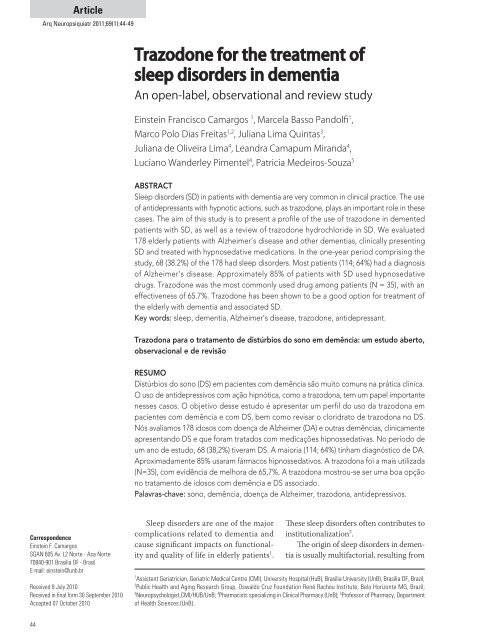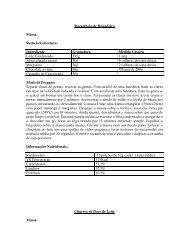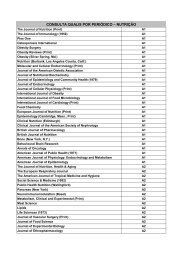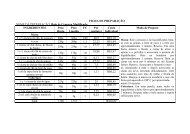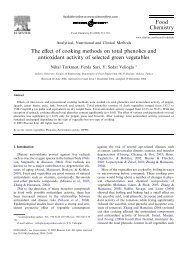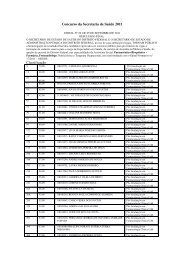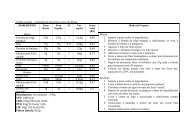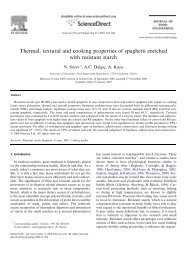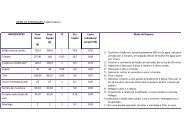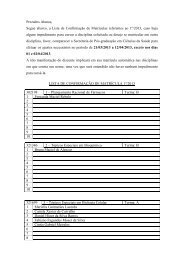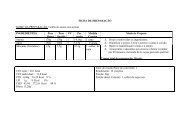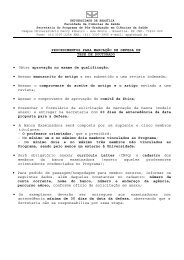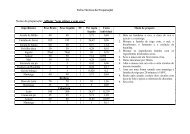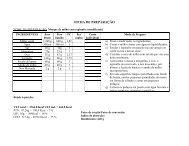Trazodone for the treatment of sleep disorders in dementia - UnB
Trazodone for the treatment of sleep disorders in dementia - UnB
Trazodone for the treatment of sleep disorders in dementia - UnB
You also want an ePaper? Increase the reach of your titles
YUMPU automatically turns print PDFs into web optimized ePapers that Google loves.
Article<br />
Arq Neuropsiquiatr 2011;69(1):44-49<br />
<strong>Trazodone</strong> <strong>for</strong> <strong>the</strong> <strong>treatment</strong> <strong>of</strong><br />
<strong>sleep</strong> <strong>disorders</strong> <strong>in</strong> <strong>dementia</strong><br />
An open-label, observational and review study<br />
E<strong>in</strong>ste<strong>in</strong> Francisco Camargos 1 , Marcela Basso Pandolfi 1 ,<br />
Marco Polo Dias Freitas 1,2 , Juliana Lima Qu<strong>in</strong>tas 3 ,<br />
Juliana de Oliveira Lima 4 , Leandra Camapum Miranda 4 ,<br />
Luciano Wanderley Pimentel 4 , Patricia Medeiros-Souza 5<br />
ABSTRACT<br />
Sleep <strong>disorders</strong> (SD) <strong>in</strong> patients with <strong>dementia</strong> are very common <strong>in</strong> cl<strong>in</strong>ical practice. The use<br />
<strong>of</strong> antidepressants with hypnotic actions, such as trazodone, plays an important role <strong>in</strong> <strong>the</strong>se<br />
cases. The aim <strong>of</strong> this study is to present a pr<strong>of</strong>ile <strong>of</strong> <strong>the</strong> use <strong>of</strong> trazodone <strong>in</strong> demented<br />
patients with SD, as well as a review <strong>of</strong> trazodone hydrochloride <strong>in</strong> SD. We evaluated<br />
178 elderly patients with Alzheimer’s disease and o<strong>the</strong>r <strong>dementia</strong>s, cl<strong>in</strong>ically present<strong>in</strong>g<br />
SD and treated with hypnosedative medications. In <strong>the</strong> one-year period compris<strong>in</strong>g <strong>the</strong><br />
study, 68 (38.2%) <strong>of</strong> <strong>the</strong> 178 had <strong>sleep</strong> <strong>disorders</strong>. Most patients (114; 64%) had a diagnosis<br />
<strong>of</strong> Alzheimer’s disease. Approximately 85% <strong>of</strong> patients with SD used hypnosedative<br />
drugs. <strong>Trazodone</strong> was <strong>the</strong> most commonly used drug among patients (N = 35), with an<br />
effectiveness <strong>of</strong> 65.7%. <strong>Trazodone</strong> has been shown to be a good option <strong>for</strong> <strong>treatment</strong> <strong>of</strong><br />
<strong>the</strong> elderly with <strong>dementia</strong> and associated SD.<br />
Key words: <strong>sleep</strong>, <strong>dementia</strong>, Alzheimer’s disease, trazodone, antidepressant.<br />
Trazodona para o tratamento de distúrbios do sono em demência: um estudo aberto,<br />
observacional e de revisão<br />
RESUMO<br />
Distúrbios do sono (DS) em pacientes com demência são muito comuns na prática clínica.<br />
O uso de antidepressivos com ação hipnótica, como a trazodona, tem um papel importante<br />
nesses casos. O objetivo desse estudo é apresentar um perfil do uso da trazodona em<br />
pacientes com demência e com DS, bem como revisar o cloridrato de trazodona no DS.<br />
Nós avaliamos 178 idosos com doença de Alzheimer (DA) e outras demências, cl<strong>in</strong>icamente<br />
apresentando DS e que <strong>for</strong>am tratados com medicações hipnossedativas. No período de<br />
um ano de estudo, 68 (38,2%) tiveram DS. A maioria (114; 64%) t<strong>in</strong>ham diagnóstico de DA.<br />
Aproximadamente 85% usaram fármacos hipnossedativos. A trazodona foi a mais utilizada<br />
(N=35), com evidência de melhora de 65,7%. A trazodona mostrou-se ser uma boa opção<br />
no tratamento de idosos com demência e DS associado.<br />
Palavras-chave: sono, demência, doença de Alzheimer, trazodona, antidepressivos.<br />
Correspondence<br />
E<strong>in</strong>ste<strong>in</strong> F. Camargos<br />
SGAN 605 Av. L2 Norte - Asa Norte<br />
70840-901 Brasilia DF - Brasil<br />
E-mail: e<strong>in</strong>ste<strong>in</strong>@unb.br<br />
Received 8 July 2010<br />
Received <strong>in</strong> f<strong>in</strong>al <strong>for</strong>m 30 September 2010<br />
Accepted 07 October 2010<br />
Sleep <strong>disorders</strong> are one <strong>of</strong> <strong>the</strong> major<br />
complications related to <strong>dementia</strong> and<br />
cause significant impacts on functionality<br />
and quality <strong>of</strong> life <strong>in</strong> elderly patients 1 .<br />
1 Assistent Geriatrician, Geriatric Medical Centre (CMI), University Hospital (HuB), Brasilia University (<strong>UnB</strong>), Brasilia DF, Brazil;<br />
2 Public Health and Ag<strong>in</strong>g Research Group, Oswaldo Cruz Foundation René Rachou Institute, Belo Horizonte MG, Brazil;<br />
3 Neuropsychologist,CMI/HUB/<strong>UnB</strong>; 4 Pharmacists specializ<strong>in</strong>g <strong>in</strong> Cl<strong>in</strong>ical Pharmacy (<strong>UnB</strong>); 5 Pr<strong>of</strong>essor <strong>of</strong> Pharmacy, Department<br />
<strong>of</strong> Health Sciences (<strong>UnB</strong>).<br />
These <strong>sleep</strong> <strong>disorders</strong> <strong>of</strong>ten contributes to<br />
<strong>in</strong>stitutionalization 2 .<br />
The orig<strong>in</strong> <strong>of</strong> <strong>sleep</strong> <strong>disorders</strong> <strong>in</strong> <strong>dementia</strong><br />
is usually multifactorial, result<strong>in</strong>g from<br />
44
Arq Neuropsiquiatr 2011;69(1)<br />
<strong>Trazodone</strong>: <strong>sleep</strong> <strong>disorders</strong> <strong>in</strong> <strong>dementia</strong><br />
Camargos et al.<br />
pathophysiological changes associated with <strong>the</strong> disease itself,<br />
sensory deprivations such as a reduction <strong>in</strong> auditory<br />
and visual acuity, and changes <strong>in</strong> environmental stimuli<br />
such as light. Some studies have shown that damage<br />
to chol<strong>in</strong>ergic neurons may contribute to changes <strong>in</strong> <strong>the</strong><br />
<strong>sleep</strong> <strong>of</strong> patients with Alzheimer’s disease (AD) 1 .<br />
Epidemiological surveys conducted <strong>in</strong> patients with<br />
AD have identified a prevalence <strong>of</strong> <strong>sleep</strong> <strong>disorders</strong> <strong>in</strong> up<br />
to 40% <strong>of</strong> patients with any stage <strong>of</strong> <strong>the</strong> disease 3 .<br />
A longitud<strong>in</strong>al study conducted with 76 elderly demented<br />
patients over two years revealed that 24% <strong>of</strong> study<br />
participants used a hypnosedative drug chronically, <strong>in</strong>creas<strong>in</strong>g<br />
from 3 to 17% <strong>in</strong> <strong>the</strong> first year, and rema<strong>in</strong><strong>in</strong>g<br />
high at 13% <strong>in</strong> <strong>the</strong> second year 4 . In <strong>the</strong> study <strong>of</strong> Grace<br />
and colleagues, <strong>in</strong> which <strong>the</strong> use <strong>of</strong> hypnosedative drugs<br />
was recorded <strong>in</strong> less than 30% <strong>of</strong> patients with <strong>sleep</strong> <strong>disorders</strong>,<br />
<strong>the</strong> authors argued that <strong>the</strong>re was reluctance by<br />
doctors to use hypnotic drugs <strong>in</strong> demented patients with<br />
<strong>sleep</strong> <strong>disorders</strong> 5 . Appropriate <strong>treatment</strong> <strong>of</strong> <strong>sleep</strong> <strong>disorders</strong><br />
may benefit both patients and <strong>the</strong>ir caregivers.<br />
Antidepressants with hypnotic action, such as trazodone,<br />
have played important roles <strong>in</strong> treat<strong>in</strong>g <strong>the</strong> elderly<br />
with <strong>sleep</strong> <strong>disorders</strong>, particularly <strong>in</strong> patients with<br />
<strong>dementia</strong> 1 . The <strong>the</strong>rapeutic dose to <strong>in</strong>duce <strong>sleep</strong> us<strong>in</strong>g<br />
<strong>the</strong>se drugs is much smaller than that used <strong>for</strong> depression,<br />
show<strong>in</strong>g effectiveness <strong>in</strong> <strong>in</strong>duc<strong>in</strong>g <strong>sleep</strong> and little<br />
mood alteration effects.<br />
<strong>Trazodone</strong> has proved to be effective <strong>in</strong> <strong>the</strong> <strong>treatment</strong><br />
<strong>of</strong> <strong>sleep</strong> <strong>disorders</strong> <strong>in</strong> depressed patients (not always older)<br />
6-8 , <strong>in</strong> secondary <strong>sleep</strong> <strong>disorders</strong> when compared to<br />
o<strong>the</strong>r substances 9,10 and <strong>in</strong> healthy <strong>in</strong>dividuals 11 .<br />
Assessments <strong>of</strong> <strong>the</strong> cl<strong>in</strong>ical response to trazodone hydrochloride<br />
<strong>for</strong> <strong>the</strong> <strong>treatment</strong> <strong>of</strong> <strong>sleep</strong> <strong>disorders</strong> <strong>in</strong> demented<br />
patients may contribute to <strong>the</strong> pool <strong>of</strong> <strong>the</strong>rapeutic<br />
options <strong>for</strong> <strong>the</strong>se patients.<br />
The objective <strong>of</strong> this analysis was to establish a pr<strong>of</strong>ile<br />
<strong>of</strong> <strong>the</strong> use <strong>of</strong> hypnosedative drugs <strong>in</strong> demented patients<br />
with <strong>sleep</strong> <strong>disorders</strong>, with an emphasis on trazodone hydrochloride<br />
and its effectiveness. This is an open-label,<br />
uncontrolled, observational study. General data and specific<br />
analysis <strong>of</strong> <strong>sleep</strong> <strong>disorders</strong> have been <strong>the</strong> aims <strong>of</strong> ano<strong>the</strong>r<br />
publication.<br />
METHOD<br />
This is a retrospective study that was previously approved<br />
by <strong>the</strong> Ethics Research Committee <strong>of</strong> <strong>the</strong> University<br />
<strong>of</strong> Brasilia. To be <strong>in</strong>cluded, patients had to be diagnosed<br />
with <strong>dementia</strong> and followed <strong>for</strong> at least 12 months,<br />
dur<strong>in</strong>g which time <strong>the</strong>y were exam<strong>in</strong>ed periodically every<br />
two months. The visits <strong>of</strong> each patient dur<strong>in</strong>g 2008<br />
and <strong>the</strong>ir records from visits <strong>in</strong> previous years s<strong>in</strong>ce <strong>the</strong>ir<br />
first consultation were considered <strong>for</strong> selection and analysis.<br />
Among <strong>the</strong> 250 patients followed <strong>in</strong> <strong>the</strong> Geriatric<br />
Medical Centre <strong>of</strong> <strong>the</strong> University’s General Hospital <strong>in</strong><br />
2008 (Cognitive Geriatric Unit), 128 were excluded: follow-up<br />
<strong>of</strong> less than one year (n=39), mild cognitive impairment<br />
(n=20), o<strong>the</strong>r possible causes <strong>of</strong> cognitive impairment<br />
cognitive (depression, hypothyroidism, syphilis,<br />
use <strong>of</strong> medication and alcohol <strong>in</strong>take) (n=13). Sleep <strong>disorders</strong><br />
were present <strong>in</strong> 31.4% (56/178) <strong>of</strong> patients at <strong>the</strong><br />
time <strong>of</strong> admission and <strong>in</strong> 38.2% (68/178) at end <strong>of</strong> followup.<br />
Basel<strong>in</strong>e characteristics <strong>for</strong> <strong>the</strong> patients are summarized<br />
<strong>in</strong> Table 1. The Centre is accredited by <strong>the</strong> M<strong>in</strong>istry<br />
<strong>of</strong> Health as a reference center <strong>for</strong> patients with Alzheimer’s<br />
disease <strong>in</strong> <strong>the</strong> Brazilian Federal District.<br />
Demographic and cl<strong>in</strong>ical data collected by <strong>in</strong>terview<br />
and evaluation consisted <strong>of</strong>: gender, age, educational level,<br />
functionality, co-morbidities, aggressiveness, type <strong>of</strong><br />
<strong>dementia</strong> and cl<strong>in</strong>ical data was ga<strong>the</strong>red us<strong>in</strong>g <strong>the</strong> Objective<br />
Geriatric Assessment, a screen<strong>in</strong>g <strong>in</strong>strument developed<br />
<strong>for</strong> teach<strong>in</strong>g and research <strong>in</strong> <strong>the</strong> Centre. Patients had<br />
complete physical exam<strong>in</strong>ations, laboratory tests [thyroid-stimulat<strong>in</strong>g<br />
hormone (TSH), vitam<strong>in</strong> B12, VDRL,<br />
biochemistry screen, and blood count] and imag<strong>in</strong>g exam<strong>in</strong>ations<br />
[magnetic resonance imag<strong>in</strong>g (MRI) and/or<br />
skull tomography].<br />
The DSM-IV criteria 12 were used <strong>for</strong> <strong>the</strong> diagnosis<br />
<strong>of</strong> <strong>dementia</strong> and those <strong>of</strong> NINCDS-ADRDA 13 <strong>for</strong> AD<br />
(probable). Functionality was established us<strong>in</strong>g <strong>the</strong> Assessment<br />
<strong>of</strong> Instrumental Activities <strong>of</strong> Daily Life 14 . M<strong>in</strong>i<br />
Mental State Exam<strong>in</strong>ation 15 and Cl<strong>in</strong>ical Dementia Rat<strong>in</strong>g<br />
(CDR) 16 were used <strong>in</strong> <strong>the</strong> cognitive assessment and <strong>in</strong><br />
<strong>the</strong> characterization <strong>of</strong> <strong>the</strong> <strong>dementia</strong> stage, respectively.<br />
The NPI (Nighttime Behavior) scale <strong>in</strong>cludes eight<br />
items that are rated as to how <strong>of</strong>ten <strong>the</strong>y occurred dur<strong>in</strong>g<br />
<strong>the</strong> past month 17 . Were considered to have a <strong>sleep</strong><br />
disorder when all <strong>the</strong> follow<strong>in</strong>g criteria: [1] Compla<strong>in</strong>t<br />
<strong>of</strong> <strong>sleep</strong> disorder from patient or caregiver (NPI items -<br />
nighttime behavior); [2] Exhaustion <strong>of</strong> caregiver (score<br />
≥2; scale from 0 to 5, with 2 <strong>in</strong>dicat<strong>in</strong>g mild distress).<br />
Polysomnography and actigraphy were not per<strong>for</strong>med,<br />
and structured <strong>sleep</strong> diaries were not requested<br />
because <strong>of</strong> <strong>the</strong> low educational level <strong>of</strong> patients and caregivers<br />
and <strong>the</strong> high proportion <strong>of</strong> patients with advanced<br />
degrees <strong>of</strong> <strong>dementia</strong>.<br />
The presence <strong>of</strong> all <strong>of</strong> <strong>the</strong> items below (1 and 2) was<br />
<strong>the</strong> criterion <strong>for</strong> effectiveness <strong>in</strong> <strong>the</strong> <strong>treatment</strong> <strong>of</strong> <strong>sleep</strong><br />
<strong>disorders</strong>: 1. Improvement <strong>of</strong> <strong>the</strong> <strong>sleep</strong> disorder compla<strong>in</strong>t.<br />
2. Reduction <strong>in</strong> <strong>the</strong> exhaustion <strong>of</strong> <strong>the</strong> caregiver <strong>in</strong><br />
<strong>the</strong> item <strong>of</strong> NPI that deals with night behavior <strong>disorders</strong><br />
<strong>for</strong> 1 (m<strong>in</strong>imum) or 0 (absent).<br />
The effectiveness percentile was calculated us<strong>in</strong>g <strong>the</strong><br />
number <strong>of</strong> patients who showed evidence <strong>of</strong> improvement<br />
<strong>in</strong> <strong>the</strong>ir <strong>sleep</strong> disorder by <strong>the</strong> total number <strong>of</strong> patients<br />
treated with this drug. Adverse events were collected<br />
by spontaneous (unsolicited) report<strong>in</strong>g.<br />
45
<strong>Trazodone</strong>: <strong>sleep</strong> <strong>disorders</strong> <strong>in</strong> <strong>dementia</strong><br />
Camargos et al.<br />
Arq Neuropsiquiatr 2011;69(1)<br />
Table 1. Basel<strong>in</strong>e characteristics <strong>of</strong> subjects.<br />
Characteristics N=178 (%) With SD (n=68) (%) Without SD (n=110) (%)<br />
Educational level <strong>in</strong> years<br />
Illiterate 33 (18.5) 15 (22.1) 18 (16.4)<br />
Less than 4 years 80 (44.9) 33 (48.5) 47 (42.7)<br />
Between 4 and 8 years 33 (18.5) 10 (14.7) 23 (20.9)<br />
More than 8 years 32 (18.1) 10 (14.7) 22 (20)<br />
Most frequent co-morbidities<br />
Systemic blood hypertension 105 (59) 38 (55.9) 67 (60.9)<br />
Dyslipidemia 38 (21.6) 13 (19.1) 25 (22.7)<br />
Diabetes mellitus 35 (19.7) 16 (23.5) 19 (17.3)<br />
Smok<strong>in</strong>g 35 (19.7) 15 (22.1) 20 (18.2)<br />
Hypothyroidism 25 (14) 10 (14.7) 15 (13.6)<br />
Previous stroke 22 (12.4) 8 (11.8) 14 (12.7)<br />
Coronary artery disease 12 (6.7) 3 (4.4) 9 (8.2)<br />
Functionality (IADL <strong>in</strong>strument)<br />
Dependent 137 (77) 52 (76.5) 85 (77.3)<br />
Independent 41 (23) 16 (23.5) 25 (22.7)<br />
Types <strong>of</strong> <strong>dementia</strong>s<br />
AD 114 (64) 43 (63.2) 71 (64.5)<br />
Mixed 24 (13.5) 9 (13.2) 15 (13.7)<br />
VD 13 (7.3) 7 (10.2) 6 (5.5)<br />
FTD 9 (5) 5 (7.4) 4 (3.6)<br />
LBD 7 (4) 2 (3) 5 (4.5)<br />
O<strong>the</strong>rs 11 (6.2) 2 (3) 9 (8.2)<br />
CDR<br />
1 77 (43.2) 27 (39.7) 50 (45.5)<br />
2 85 (47.8) 35 (51.5) 50 (45.5)<br />
3 16 (9) 6 (8.8) 10 (9.1)<br />
Report <strong>of</strong> aggressiveness<br />
Yes 109 (61.2) 46 (67.6) 63 (57.3)<br />
No 69 (38.8) 22 (32.4) 47 (42.7)<br />
SD: <strong>sleep</strong> disorder; VD: vascular disease; FTD: frontotemporal <strong>dementia</strong>; LBD: Lewy body <strong>dementia</strong>; CDR: cl<strong>in</strong>ical <strong>dementia</strong> rat<strong>in</strong>g.<br />
Table 2. Most commonly used drugs <strong>for</strong> <strong>the</strong> <strong>treatment</strong> <strong>of</strong> <strong>sleep</strong> <strong>disorders</strong> <strong>in</strong> patients<br />
with <strong>dementia</strong> <strong>in</strong> follow-up.<br />
Drugs<br />
N<br />
Evidence <strong>of</strong><br />
improvement N (%)<br />
Dose<br />
(mg/day)<br />
<strong>Trazodone</strong> 35 23 (65.7) 50-100<br />
Clonazepam 23 16 (69.5) 0.5-2<br />
Mirtazap<strong>in</strong>e 20 17 (85) 15-30<br />
Mianser<strong>in</strong> 16 10 (62.5) 30<br />
O<strong>the</strong>rs 13 9 (69.2) –<br />
46
Arq Neuropsiquiatr 2011;69(1)<br />
<strong>Trazodone</strong>: <strong>sleep</strong> <strong>disorders</strong> <strong>in</strong> <strong>dementia</strong><br />
Camargos et al.<br />
Table 3. Polysomnographic <strong>sleep</strong> variables with <strong>the</strong> use <strong>of</strong> trazodone <strong>in</strong> chosen studies.<br />
Studies<br />
Mouret<br />
et al. 6<br />
Scharf e<br />
Sachais 7<br />
Bemmel<br />
et al. 8<br />
Montgomery<br />
et al. 28<br />
Haffmans<br />
e Vos 9<br />
Suzuki<br />
et al. 11<br />
Kaynak<br />
et al. 10<br />
Mean age (year) 30.1 43.5 61 44 23.9 42 24<br />
Sleep onset latency ↓ ↓ → → → → → →<br />
% stage 2 ↑ → → ↑ ↑ ↓ → →<br />
% stage 3, 4 ↑ ↑ → ↑ ↑ ↑ ↑ ↑<br />
REM latency ↑ ↑ ↑ ↑ → → → ↑*<br />
% REM → ↓ ↓ ↓ → → →<br />
Total <strong>sleep</strong> time ↑ ↑ → → → → ↑ →<br />
Nº <strong>of</strong> awaken<strong>in</strong>gs ↓ ↓ → ↓ ↓ ‡ ↓ ↓*<br />
Dose used (mg/day) 400-600 150-400 300-400 150 50 50-100 100 200<br />
Special caracteristics<br />
depressed<br />
patients<br />
depressed<br />
patients<br />
major<br />
depressive<br />
disorder<br />
poor <strong>sleep</strong>ers<br />
SD <strong>in</strong>duced<br />
by<br />
br<strong>of</strong>arom<strong>in</strong>e<br />
*not statistically significant; ↓decreased; ↑<strong>in</strong>creased; → not change; ‡not evaluated; SD: <strong>sleep</strong> disorder.<br />
healthy<br />
volunteers<br />
treated with<br />
stimulant<br />
antidepressants<br />
Ware e<br />
Joe 29<br />
healthy<br />
young<br />
adults<br />
Statistical analysis was per<strong>for</strong>med us<strong>in</strong>g SPSS version<br />
14.0 <strong>for</strong> W<strong>in</strong>dows (SPSS, Chicago, USA). The data<br />
frequency was exam<strong>in</strong>ed us<strong>in</strong>g <strong>the</strong> chi-squared test and<br />
t-tests were used to <strong>in</strong>vestigate basel<strong>in</strong>e differences between<br />
genders. Statistical significance was set at p0.05)<br />
with regards to average age. Most patients (114; 64%) had<br />
<strong>the</strong> diagnosis <strong>of</strong> AD.<br />
The primary <strong>sleep</strong> disorder found among <strong>the</strong> elderly<br />
participants was difficulty <strong>in</strong> ma<strong>in</strong>ta<strong>in</strong><strong>in</strong>g <strong>sleep</strong> at night<br />
(stay<strong>in</strong>g a<strong>sleep</strong>). Difficulty <strong>in</strong> fall<strong>in</strong>g a<strong>sleep</strong>, frequent<br />
arousals from <strong>sleep</strong> and early morn<strong>in</strong>g awaken<strong>in</strong>gs were<br />
observed. Although caregivers <strong>of</strong> our patients frequently<br />
compla<strong>in</strong>ed about difficulties <strong>in</strong> <strong>sleep</strong> ma<strong>in</strong>tenance, <strong>the</strong><br />
patients’ <strong>sleep</strong> <strong>disorders</strong> could not be classified. Table 2<br />
shows <strong>the</strong> most commonly used drugs <strong>for</strong> <strong>the</strong> <strong>treatment</strong><br />
<strong>of</strong> <strong>sleep</strong> <strong>disorders</strong> <strong>in</strong> patients with <strong>dementia</strong> (some used<br />
more than one medication).<br />
The o<strong>the</strong>r drugs (N=13) were comb<strong>in</strong>ed <strong>in</strong>to a s<strong>in</strong>gle<br />
group known as “o<strong>the</strong>rs”, represented by benzodiazep<strong>in</strong>es<br />
(triazolam, estazolam, and midazolam), antipsychotics<br />
(olanzap<strong>in</strong>e and thioridaz<strong>in</strong>e) and non-benzodiazep<strong>in</strong>e<br />
<strong>in</strong>ducers (zolpidem).<br />
The average time <strong>of</strong> use <strong>of</strong> antidepressants <strong>in</strong> months<br />
<strong>for</strong> <strong>the</strong> <strong>treatment</strong> <strong>of</strong> <strong>sleep</strong> <strong>disorders</strong> was 8.1 (±4) <strong>for</strong> trazodone,<br />
18.6 (±10.1) <strong>for</strong> mirtazap<strong>in</strong>e and 19.3 (±6.8) <strong>for</strong><br />
mianser<strong>in</strong>.<br />
<strong>Trazodone</strong> was used at a dose <strong>of</strong> 50 mg/day (at bedtime)<br />
<strong>in</strong> most patients (34) and 100 mg/day <strong>in</strong> one patient.<br />
No adverse effects were reported (spontaneously).<br />
In <strong>the</strong> cases where non-effectiveness <strong>of</strong> <strong>treatment</strong> was experienced<br />
(12), such non-effectiveness was observed from<br />
<strong>the</strong> first days <strong>of</strong> <strong>treatment</strong>, except <strong>for</strong> one case <strong>in</strong> which<br />
non-effectiveness began after 5 months <strong>of</strong> drug use.<br />
DISCUSSION<br />
<strong>Trazodone</strong> is among <strong>the</strong> antidepressants used with<br />
good tolerability <strong>in</strong> this sample, show<strong>in</strong>g effectiveness <strong>in</strong><br />
2/3 <strong>of</strong> patients.<br />
Antidepressants are a suitable option <strong>for</strong> <strong>the</strong> <strong>treatment</strong><br />
<strong>of</strong> <strong>sleep</strong> <strong>disorders</strong> <strong>in</strong> <strong>the</strong> elderly 18 . Tricyclic antidepressants<br />
such as amitriptyl<strong>in</strong>e, imipram<strong>in</strong>e and cloimipram<strong>in</strong>e,<br />
have been used to <strong>in</strong>duce <strong>sleep</strong> <strong>in</strong> patients without<br />
<strong>dementia</strong>, especially when <strong>the</strong> <strong>sleep</strong> disorder is associated<br />
with depression 19 . However, <strong>the</strong>ir antichol<strong>in</strong>ergic<br />
action may lead to impaired cognition and risk <strong>of</strong> mental<br />
confusion.<br />
<strong>Trazodone</strong> <strong>of</strong>fers a dual action on seroton<strong>in</strong> receptors<br />
by block<strong>in</strong>g serotonergic receptor 2A (5HT2A) and<br />
<strong>in</strong>hibit<strong>in</strong>g seroton<strong>in</strong> reuptake. Phenylpiperaz<strong>in</strong>es are differentiated<br />
from tricyclic antidepressants s<strong>in</strong>ce <strong>the</strong>y show<br />
greater selectivity <strong>for</strong> 5HT2A receptors. With regard to<br />
<strong>the</strong> block<strong>in</strong>g <strong>of</strong> seroton<strong>in</strong> reuptake, trazodone is less potent<br />
than tricyclic antidepressants or selective seroton<strong>in</strong><br />
reuptake <strong>in</strong>hibitors (SSRIs), and also blocks alpha 1 receptors.<br />
There is also a blockade <strong>of</strong> histam<strong>in</strong>ergic receptors,<br />
thus differ<strong>in</strong>g from nefazodone; this block<strong>in</strong>g <strong>of</strong> histam<strong>in</strong>ergic<br />
receptors may be responsible <strong>for</strong> <strong>the</strong> extreme<br />
sedative effect <strong>of</strong> this drug. As a result <strong>of</strong> <strong>sleep</strong><strong>in</strong>ess <strong>in</strong>duced<br />
as a side-effect, even with <strong>of</strong>f-label use, trazodone<br />
has been used <strong>in</strong> various circumstances <strong>in</strong> which <strong>the</strong><br />
ma<strong>in</strong> goal is <strong>sleep</strong> <strong>in</strong>duction 20 , but not <strong>in</strong> dements patients.<br />
<strong>Trazodone</strong> has also been used as an adjuvant to<br />
o<strong>the</strong>r antidepressants because it <strong>in</strong>creases <strong>the</strong> tolerabili-<br />
47
<strong>Trazodone</strong>: <strong>sleep</strong> <strong>disorders</strong> <strong>in</strong> <strong>dementia</strong><br />
Camargos et al.<br />
Arq Neuropsiquiatr 2011;69(1)<br />
ty <strong>of</strong> <strong>the</strong>se antidepressant by work<strong>in</strong>g to reduce <strong>the</strong>ir <strong>in</strong>duced<br />
adverse effects via <strong>the</strong> block<strong>in</strong>g <strong>of</strong> 5HT2A receptors<br />
(stimulated by SSRI) 21 .<br />
The classic <strong>in</strong>dication <strong>of</strong> trazodone is <strong>for</strong> depression,<br />
particularly when anxiety and <strong>in</strong>somnia are also present.<br />
The usual daily dose <strong>for</strong> improvement <strong>of</strong> <strong>the</strong> <strong>sleep</strong> disorder<br />
compla<strong>in</strong>t varies between 150 and 200 mg/day. Extreme<br />
doses <strong>of</strong> 50 and 600 mg/day may be used <strong>in</strong> specific<br />
cases. Lower doses, between 25 and 100 mg/day, have<br />
been prescribed as a hypnosedative <strong>for</strong> patients with <strong>in</strong>somnia<br />
and to correct <strong>the</strong> adverse effects <strong>of</strong> <strong>in</strong>somnia<br />
caused by SSRIs 22 . Due to its relative safety and its low<br />
<strong>in</strong>hibition <strong>of</strong> chol<strong>in</strong>ergic receptors, trazodone has been<br />
used <strong>in</strong> <strong>the</strong> <strong>treatment</strong> <strong>of</strong> depression <strong>in</strong> elderly patients<br />
with cardiovascular disease. Reduced antichol<strong>in</strong>ergic effect<br />
allows its use <strong>in</strong> elderly patients with cardiovascular<br />
impairments and delirium.<br />
Most studies evaluat<strong>in</strong>g trazodone <strong>in</strong> <strong>the</strong> <strong>treatment</strong><br />
<strong>of</strong> <strong>sleep</strong> <strong>disorders</strong> were conducted <strong>in</strong> patients with depression.<br />
Saletu-Zyhlarz and collaborators, us<strong>in</strong>g polysomnography,<br />
evaluated 11 <strong>in</strong>dividuals with depression<br />
and <strong>sleep</strong> <strong>disorders</strong> and compared <strong>the</strong>m to 11 healthy<br />
subjects. The authors observed an improvement <strong>in</strong><br />
<strong>sleep</strong> parameters with <strong>the</strong> use <strong>of</strong> 100 mg/day <strong>of</strong> trazodone<br />
23 . There was an <strong>in</strong>crease <strong>in</strong> <strong>sleep</strong> total time, as we<br />
well as a reduction <strong>in</strong> nighttime and early awaken<strong>in</strong>gs.<br />
This study also reported improvements <strong>in</strong> <strong>the</strong> subjective<br />
quality <strong>of</strong> <strong>sleep</strong>, <strong>sleep</strong> efficiency, numerical memory<br />
and somatic compla<strong>in</strong>ts. This improvement <strong>in</strong> memory<br />
may be welcomed <strong>in</strong> cases <strong>of</strong> patients with <strong>dementia</strong>.<br />
In our study, <strong>the</strong> patients did not use trazodone at<br />
doses higher than 100 mg/day, which may have contributed<br />
to a lower effectiveness when compared to mirtazap<strong>in</strong>e.<br />
There appears to be some improvement <strong>in</strong><br />
<strong>sleep</strong> parameters with <strong>in</strong>creas<strong>in</strong>g doses <strong>of</strong> trazodone 6,7,10 .<br />
Nierenberg and colleagues reported good <strong>in</strong> subjective<br />
<strong>sleep</strong> parameters (PSQI - Pittsburgh Index) with <strong>the</strong><br />
use <strong>of</strong> 50 mg/day <strong>of</strong> trazodone while evaluat<strong>in</strong>g patients<br />
with secondary <strong>in</strong>somnia with <strong>the</strong> use <strong>of</strong> antidepressants<br />
24 . Similar f<strong>in</strong>d<strong>in</strong>gs were observed by Kaynak us<strong>in</strong>g<br />
trazodone at a dose <strong>of</strong> 100 mg/day, with subjective and<br />
objective improvement <strong>of</strong> quality <strong>of</strong> <strong>sleep</strong> after one week<br />
<strong>of</strong> <strong>treatment</strong> 10 .<br />
Despite <strong>the</strong> improvement <strong>in</strong> <strong>sleep</strong> parameters reported<br />
<strong>in</strong> most studies, polysomnographic f<strong>in</strong>d<strong>in</strong>gs vary<br />
among studies, probably due to differences <strong>in</strong> <strong>the</strong> dose<br />
used and age <strong>of</strong> <strong>the</strong> participants (Table 3).<br />
<strong>Trazodone</strong> has been shown to be effective <strong>in</strong> <strong>the</strong> elderly<br />
population ma<strong>in</strong>ly due to associated reduced antichol<strong>in</strong>ergic<br />
effects and undetectable electrocardiographic<br />
changes. Ano<strong>the</strong>r important aspect <strong>of</strong> this drug is its<br />
good tolerability as a <strong>treatment</strong> <strong>for</strong> depression <strong>in</strong> elderly<br />
patients. In <strong>the</strong> current study, 1/3 term<strong>in</strong>ated <strong>treatment</strong><br />
with trazodone due to a lack <strong>of</strong> effectiveness but not<br />
due to adverse effects. The study <strong>of</strong> Lebert and colleagues<br />
showed no <strong>in</strong>crease <strong>in</strong> adverse effects <strong>of</strong> trazodone <strong>in</strong> patients<br />
with <strong>dementia</strong> 25 .<br />
The mechanism <strong>in</strong>volved <strong>in</strong> <strong>the</strong> sedative effect <strong>of</strong><br />
some antidepressants, among <strong>the</strong>m trazodone, rema<strong>in</strong>s<br />
unclear. It is not known whe<strong>the</strong>r <strong>the</strong>re is an improvement<br />
<strong>in</strong> <strong>sleep</strong> due to an improvement <strong>in</strong> depression or whe<strong>the</strong>r<br />
<strong>the</strong> improved <strong>sleep</strong> is due to <strong>the</strong> direct action <strong>of</strong> <strong>the</strong> medication<br />
11 . Kaynak and collaborators suggest that <strong>the</strong> <strong>the</strong>rapeutic<br />
effect <strong>of</strong> trazodone on <strong>sleep</strong> is <strong>in</strong>dependent <strong>of</strong> its<br />
antidepressant effect 10 .<br />
<strong>Trazodone</strong> and o<strong>the</strong>r antidepressants with strong antagonism<br />
<strong>of</strong> 5-HT2 receptors have properties that <strong>in</strong>crease<br />
<strong>the</strong> slow-wave <strong>sleep</strong> <strong>in</strong> healthy volunteers and <strong>in</strong><br />
depressed patients with <strong>in</strong>somnia 26 .<br />
The risk <strong>of</strong> priapism and trazodone-related cardiac<br />
arrhythmia is low and is only associated with high doses.<br />
The alpha-adrenergic blockade caused by trazodone<br />
is thought to <strong>the</strong> mechanism responsible <strong>for</strong> priapism 22 .<br />
Limitations <strong>of</strong> this study <strong>in</strong>clude: absence <strong>of</strong> an<br />
<strong>in</strong>strument to ensure that all patients met diagnostic<br />
criteria <strong>for</strong> <strong>sleep</strong> <strong>disorders</strong>; <strong>the</strong> lack <strong>of</strong> a double-bl<strong>in</strong>d<br />
design; drugs eligibility was determ<strong>in</strong>ed on <strong>the</strong> basis <strong>of</strong><br />
physician’s cl<strong>in</strong>ical judgment, because this study sought<br />
to reflect <strong>the</strong> manner <strong>in</strong> which physicians treat SD <strong>in</strong> dement<br />
elderly; <strong>in</strong><strong>for</strong>mation regard<strong>in</strong>g <strong>the</strong> effectiveness <strong>of</strong><br />
<strong>the</strong>se drugs cannot be so clearly, s<strong>in</strong>ce different drugs<br />
might be selected <strong>for</strong> different purposes. For example,<br />
a highly effective drug might look <strong>in</strong>effective s<strong>in</strong>ce doctors<br />
might tend to use it only <strong>in</strong> <strong>the</strong> most refractory patients;<br />
absence <strong>of</strong> a placebo control group, it is not possible<br />
to draw def<strong>in</strong>itive conclusions as one might with<br />
a randomized, bl<strong>in</strong>ded trial; under-report<strong>in</strong>g is a recognized<br />
limitation <strong>of</strong> studies based upon spontaneous adverse<br />
event report<strong>in</strong>g.<br />
None<strong>the</strong>less, <strong>the</strong> results <strong>of</strong> this study, <strong>in</strong> an apparently<br />
representative cohort <strong>of</strong> demented elderly, provide useful<br />
and cl<strong>in</strong>ically relevant <strong>in</strong><strong>for</strong>mation. This study was <strong>in</strong>tended<br />
to show <strong>the</strong> effectiveness <strong>of</strong> drugs (trazodone, specially)<br />
to SD <strong>in</strong> demented elderly under ‘real world’ conditions<br />
and make a review. References are cited spann<strong>in</strong>g<br />
at least three decades <strong>of</strong> research.<br />
Accord<strong>in</strong>g to Erman, <strong>the</strong> lack <strong>of</strong> studies on <strong>the</strong> chronic<br />
use <strong>of</strong> trazodone is a reflection <strong>of</strong> <strong>the</strong> lack <strong>of</strong> <strong>in</strong>terest<br />
by health authorities and pharmaceutical <strong>in</strong>dustries<br />
to develop controlled studies with placebo and doublebl<strong>in</strong>d<br />
groups to assess <strong>the</strong> effectiveness and safety <strong>of</strong> <strong>the</strong><br />
drug <strong>in</strong> <strong>the</strong>se patients, s<strong>in</strong>ce <strong>the</strong> drug has no more patent<br />
reserves 27 . The literature reveals <strong>the</strong> need <strong>for</strong> controlled,<br />
prospective, double-bl<strong>in</strong>d and randomized studies<br />
to evaluate <strong>the</strong> benefits <strong>of</strong> trazodone <strong>in</strong> this particular<br />
segment <strong>of</strong> <strong>the</strong> population with <strong>dementia</strong> 20,28,29 .<br />
48
Arq Neuropsiquiatr 2011;69(1)<br />
<strong>Trazodone</strong>: <strong>sleep</strong> <strong>disorders</strong> <strong>in</strong> <strong>dementia</strong><br />
Camargos et al.<br />
ACKNOWLEDGMENTS – We thank Pr<strong>of</strong>. Pedro Tauil, MD, PhD, <strong>for</strong><br />
assistance <strong>in</strong> method construction and data analysis.<br />
REFERENCES<br />
1. Vitiello MV, Borson S. Sleep disturbances <strong>in</strong> patients with Alzheimer’s<br />
disease: epidemiology, pathophysiology and <strong>treatment</strong>. CNS Drugs<br />
2001;15:777-796.<br />
2. Hope T, Keene J, Gedl<strong>in</strong>g K, Fairburn CG, Jacoby R. Predictors <strong>of</strong> <strong>in</strong>stitutionalization<br />
<strong>for</strong> people with <strong>dementia</strong> liv<strong>in</strong>g at home with a carer. Int J Geriatr<br />
Psychiatry 1998;13:682-690.<br />
3. McCurry SM, Logsdon RG, Teri L, et al. Characteristics <strong>of</strong> <strong>sleep</strong> disturbance<br />
<strong>in</strong> community-dwell<strong>in</strong>g Alzheimer’s disease patients. J Geriatr Psychiatry<br />
Neurol 1999;12:53-59.<br />
4. Elmstahl S, Stenberg I, Annerstedt L, Ingvad B. Behavioral disturbances and<br />
pharmacological <strong>treatment</strong> <strong>of</strong> patients with <strong>dementia</strong> <strong>in</strong> family caregiv<strong>in</strong>g:<br />
a 2-year follow-up. Int Psychogeriatr 1998;10:239-252.<br />
5. Grace JB, Walker MP, McKeith IG. A comparison <strong>of</strong> <strong>sleep</strong> pr<strong>of</strong>iles <strong>in</strong> patients<br />
with <strong>dementia</strong> with lewy bodies and Alzheimer’s disease. Int J Geriatr Psychiatry<br />
2000;15:1028-1033.<br />
6. Mouret J, Lemo<strong>in</strong>e P, M<strong>in</strong>uit MP, Benkelfat C, Renardet M. Effects <strong>of</strong> trazodone<br />
on <strong>the</strong> <strong>sleep</strong> <strong>of</strong> depressed subjects: a polygraphic study. Psychopharmacology<br />
(Berl) 1988;95(Suppl):S37-S43.<br />
7. Scharf MB, Sachais BA. Sleep laboratory evaluation <strong>of</strong> <strong>the</strong> effects and efficacy<br />
<strong>of</strong> trazodone <strong>in</strong> depressed <strong>in</strong>somniac patients. J Cl<strong>in</strong> Psychiatry 1990;51<br />
(Suppl):S13-S17.<br />
8. van Bemmel AL, Havermans RG, van Diest R. Effects <strong>of</strong> trazodone on EEG<br />
<strong>sleep</strong> and cl<strong>in</strong>ical state <strong>in</strong> major depression. Psychopharmacology (Berl)<br />
1992; 107:569-574.<br />
9. Haffmans PM, Vos MS. The effects <strong>of</strong> trazodone on <strong>sleep</strong> disturbances <strong>in</strong>duced<br />
by br<strong>of</strong>arom<strong>in</strong>e. Eur Psychiatry 1999;14:167-171.<br />
10. Kaynak H, Kaynak D, Gozukirmizi E, Guillem<strong>in</strong>ault C. The effects <strong>of</strong> trazodone<br />
on <strong>sleep</strong> <strong>in</strong> patients treated with stimulant antidepressants. Sleep<br />
Med 2004;5:15-20.<br />
11. Suzuki H, Yamadera H, Nakamura S, Endo S. Effects <strong>of</strong> trazodone and imipram<strong>in</strong>e<br />
on <strong>the</strong> biological rhythm: an analysis <strong>of</strong> <strong>sleep</strong> EEG and body core<br />
temperature. J Nippon Med Sch 2002;69:333-341.<br />
12. APA. Diagnostic and statistical manual <strong>of</strong> mental <strong>disorders</strong>. 4th edition ed.<br />
Wash<strong>in</strong>gton, DC: American Psychiatric Association; 1994.<br />
13. McKhann G, Drachman D, Folste<strong>in</strong> M, Katzman R, Price D, Stadlan EM. Cl<strong>in</strong>ical<br />
diagnosis <strong>of</strong> Alzheimer’s disease: report <strong>of</strong> <strong>the</strong> NINCDS-ADRDA Work<br />
Group under <strong>the</strong> auspices <strong>of</strong> Department <strong>of</strong> Health and Human Services<br />
Task Force on Alzheimer’s Disease. Neurology 1984;34:939-944.<br />
14. Lawton MP, Brody EM. Assessment <strong>of</strong> older people: self-ma<strong>in</strong>ta<strong>in</strong><strong>in</strong>g and <strong>in</strong>strumental<br />
activities <strong>of</strong> daily liv<strong>in</strong>g. Gerontologist 1969;9:179-186.<br />
15. Folste<strong>in</strong> MF, Folste<strong>in</strong> SE, McHugh PR. “M<strong>in</strong>i-mental state”. A practical method<br />
<strong>for</strong> grad<strong>in</strong>g <strong>the</strong> cognitive state <strong>of</strong> patients <strong>for</strong> <strong>the</strong> cl<strong>in</strong>ician. J Psychiatr<br />
Res 1975;12:189-198.<br />
16. Hughes CP, Berg L, Danziger WL, Coben LA, Mart<strong>in</strong> RL. A new cl<strong>in</strong>ical scale<br />
<strong>for</strong> <strong>the</strong> stag<strong>in</strong>g <strong>of</strong> <strong>dementia</strong>. Br J Psychiatry 1982;140:566-572.<br />
17. Cumm<strong>in</strong>gs JL, Mega M, Gray K, et al. The Neuropsychiatric <strong>in</strong>ventory:<br />
comprehensive assessment <strong>of</strong> psychopathology <strong>in</strong> <strong>dementia</strong>. Neurology<br />
1994;44: 2308-2314.<br />
18. Doghramji K. Treatment strategies <strong>for</strong> <strong>sleep</strong> disturbance <strong>in</strong> patients with<br />
depression. J Cl<strong>in</strong> Psychiatry 2003;64 (Suppl 14):S24-S29.<br />
19. Wolkove N, Elkholy O, Baltzan M, Palayew M. Sleep and ag<strong>in</strong>g 2. Management<br />
<strong>of</strong> <strong>sleep</strong> <strong>disorders</strong> <strong>in</strong> older people. CMAJ 8 2007;176:1449-1454.<br />
20. James SP, Mendelson WB. The use <strong>of</strong> trazodone as a hypnotic: a critical review.<br />
J Cl<strong>in</strong> Psychiatry 2004;65:752-755.<br />
21. Stahl SM. Stahl’s essential psychopharmacology: neuroscientific basis and<br />
practical applications. 3rd ed, Fully rev. and expanded. ed. Cambridge ; New<br />
York: Cambridge University Press; 2008.<br />
22. Cantarelli MDG, Marcol<strong>in</strong> MA. Trazodona: farmacologia e <strong>in</strong>terações medicamentosas.<br />
Rev Psiquiatr Cl<strong>in</strong> 2006;33:329-336.<br />
23. Saletu-Zyhlarz GM, Abu-Bakr MH, Anderer P, et al. Insomnia <strong>in</strong> depression:<br />
differences <strong>in</strong> objective and subjective <strong>sleep</strong> and awaken<strong>in</strong>g quality to normal<br />
controls and acute effects <strong>of</strong> trazodone. Prog Neuropsychopharmacol<br />
Biol Psychiatry 2002;26:249-260.<br />
24. Nierenberg AA, Adler LA, Peselow E, Zornberg G, Rosenthal M. <strong>Trazodone</strong><br />
<strong>for</strong> antidepressant-associated <strong>in</strong>somnia. Am J Psychiatry 1994;151:1069-<br />
1072.<br />
25. Lebert F, Stekke W, Hasenbroekx C, Pasquier F. Frontotemporal <strong>dementia</strong>:<br />
a randomised, controlled trial with trazodone. Dement Geriatr Cogn<br />
Disord 2004;17:355-359.<br />
26. Yamadera H, Suzuki H, Nakamura S, Endo S. Effects <strong>of</strong> trazodone on polysomnography,<br />
blood concentration and core body temperature <strong>in</strong> healthy<br />
volunteers. Psychiatry Cl<strong>in</strong> Neurosci 1999;53:189-191.<br />
27. Erman MK. Is it a <strong>sleep</strong><strong>in</strong>g pill? Primary Psychiatry 2000;15:34-36.<br />
28. Montgomery I, Oswald I, Morgan K, Adam K. <strong>Trazodone</strong> enhances <strong>sleep</strong> <strong>in</strong><br />
subjective quality but not <strong>in</strong> objective duration. Br J Cl<strong>in</strong> Pharmacol 1983;16:<br />
139-144.<br />
29. Ware JC, Pittard JT. Increased deep <strong>sleep</strong> after trazodone use: a doublebl<strong>in</strong>d<br />
placebo-controlled study <strong>in</strong> healthy young adults. J Cl<strong>in</strong> Psychiatry<br />
1990;51(Suppl):S18-S22.<br />
49


